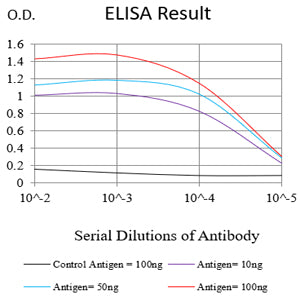
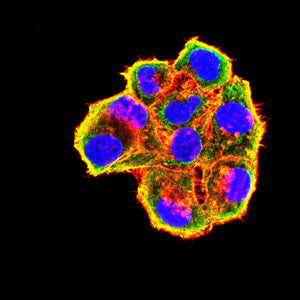
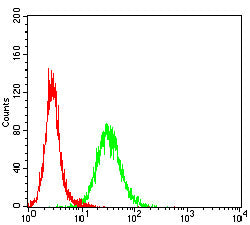
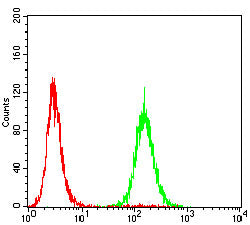
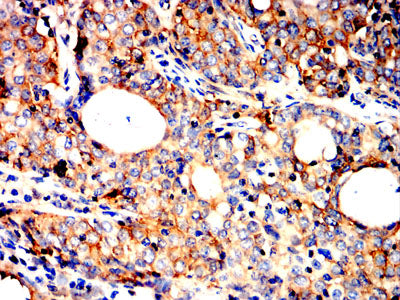
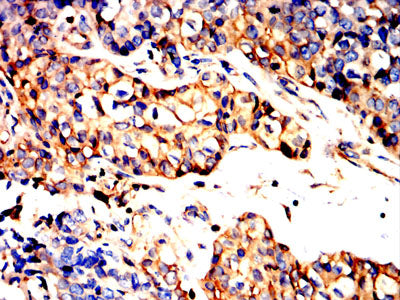
| WB | 1/500-1/1000 | Human,Mouse,Rat |
| IF | 咨询技术 | Human,Mouse,Rat |
| IHC | 1/200 - 1/1000 | Human,Mouse,Rat |
| ICC | 1/200 - 1/1000 | Human,Mouse,Rat |
| FCM | 1/200 - 1/400 | Human,Mouse,Rat |
| Elisa | 1/10000 | Human,Mouse,Rat |
| Aliases | PM227; AHNAKRS |
| Entrez GeneID | 79026 |
| clone | 8B3A4 |
| WB Predicted band size | 63KDa |
| Host/Isotype | Mouse IgG1 |
| Antibody Type | Primary antibody |
| Storage | Store at 4°C short term. Aliquot and store at -20°C long term. Avoid freeze/thaw cycles. |
| Species Reactivity | Human |
| Immunogen | Purified recombinant fragment of human AHNAK (AA: 1-200) expressed in E. Coli. |
| Formulation | Purified antibody in PBS with 0.05% sodium azide |
+ +
以下是关于AHNAK抗体的3篇参考文献及其摘要概括:
---
1. **"AHNAK interaction with the annexin 2/S100A10 complex regulates cell membrane cytoarchitecture"**
*Authors: Benaud C. et al.*
摘要:研究揭示了AHNAK通过与膜修复相关蛋白复合物(annexin 2/S100A10)的相互作用调控细胞膜结构,并开发了特异性抗体用于验证AHNAK在细胞损伤修复中的定位和功能。
2. **"AHNAK as a biomarker in breast cancer: Correlation with tumor progression"**
*Authors: Lee I.H. et al.*
摘要:利用AHNAK抗体检测乳腺癌组织中AHNAK的表达水平,发现其高表达与肿瘤侵袭性和不良预后相关,提示其作为潜在诊断标志物的价值。
3. **"AHNAK shields broken nuclear envelope in cancer cells"**
*Authors: Jaiswal J.K. et al.*
摘要:通过免疫荧光(使用AHNAK抗体)发现,AHNAK在癌细胞核膜损伤时募集至破损处,协助维持核膜完整性,为靶向癌症治疗提供新思路。
---
以上文献聚焦于AHNAK抗体在机制研究(膜修复、核膜保护)及临床诊断中的应用,涵盖基础与转化医学领域。如需具体期刊信息或年份,可进一步补充检索关键词(如“AHNAK antibody cancer”或“AHNAK knockout model”)。
AHNAK antibodies target the AHNAK nucleoprotein, a large (~700 kDa) scaffolding protein involved in cell membrane repair, cytoskeletal organization, and calcium signaling. Initially identified as a gene dysregulated in neuroblastoma, AHNAK is expressed in various tissues, including cardiac and skeletal muscle, epithelial cells, and neurons. Its structure features multiple repeating domains, enabling interactions with proteins like dysferlin, S100 calcium-binding proteins, and protein kinase C isoforms, which underpin its role in cell adhesion, motility, and signal transduction.
AHNAK's dual localization (nucleus/cytoplasm) and involvement in cancer progression (e.g., metastasis, epithelial-mesenchymal transition) have driven interest in developing antibodies for research and diagnostics. Commercially available AHNAK antibodies (polyclonal/monoclonal) are primarily used in Western blotting, immunofluorescence, and immunohistochemistry to study its expression patterns in diseases like cardiomyopathy, muscular dystrophy, and cancers (breast, lung, melanoma). However, antibody specificity remains a challenge due to AHNAK's size and repetitive domains, requiring careful validation via knockout controls.
Recent studies highlight AHNAK's potential as a cancer biomarker or therapeutic target, though conflicting data on its pro- or anti-tumor roles necessitate further investigation. Research-grade antibodies thus play a critical role in elucidating AHNAK's context-dependent functions in cellular homeostasis and pathology.
×